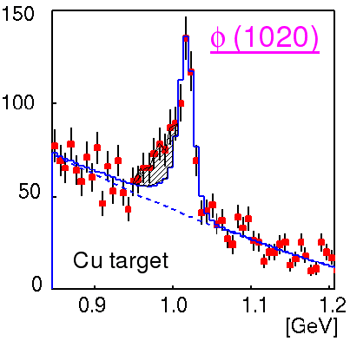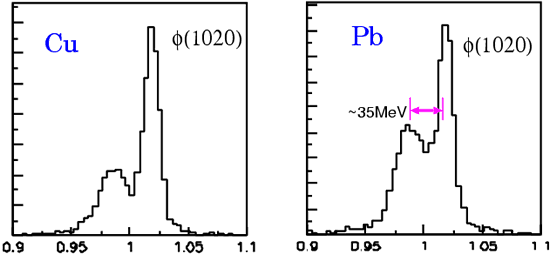J-PARC E16
Research Project C01: Experimental study of the origin of mass due to the braking of chiral symmetry
Nambu's theory dictates that the hadron masses are effectively determined, so that they can be modified when the QCD vacuum (or circumstances such as temperature and density) changes. The essential motivation of this project is to study changes of hadrons' character in different circumstances, and we chose nuclei as a laboratory with natural high density.
Our previous experiment, KEK-PS E325, confirmed that ρ, ω and φ reduce their masses at nuclear density. Fig.1 is the observed e+e− invariant mass spectrum of slowly moving φ mesons from Cu targets (PRL 98 (2007) 042501), showing an excess over the normally-expected Breit-Wigner distribution. The excess is attributed to in-medium decays and explained by assuming 3.4% of mass decrease at normal nuclear density. The observed mass decrease is consistent with the theoretical prediction (PRC 46 (1992) R34) which based on that the chiral symmetry (spontaneously broken in nature) is partially restored at nuclear density and says the mesons reduce their masses in nuclear matter according to the restoration.
In this project, we construct a large acceptance electron-pair spectrometer at J-PARC (Fig.2) and measure the mass modification (mass decrease and width broadening) systematically. Our goal is to accumulate φ mesons 100 times as much as that of our previous experiment with the improved mass resolution. Thus we can observe the two-peak structure in the φ meson spectra as shown in Fig.3, in which the left peak consists of the in-medium decays of φ, which have modified mass and width. Once two peaks are observed, the in-medium mass modification of those mesons is undoubtedly confirmed, and the width broadening can easily be de-convoluted out unlike the previous experiment. Also we can measure the momentum dependence of the mass of the φ meson, namely, the dispersion relation of the φ meson in nuclear matter, which confirms that the modification is due to the partial restoration of chiral symmetry in nuclear matter.
After the development and construction of the spectrometer, we will perform the E16 experiment at J-PARC in 2012-13.
The dynamics of mass generation depends on flavors of quark. Understanding such the mechanism is important for elucidating the generation mechanism of new hadrons as tetra/pentaquarks.
[Fig. 1]
The e+e− invariant mass spectrum of the φ meson for the Cu target, which is observed in KEK-PS E325 (PRL 98 (2007) 042501). Red squares are the data, the blue lines show the expected spectrum of φ meson in vacuum and a hatched area on the left side of the peak is considered to be the modified mesons in nuclei.

[Fig. 2]
The schematic view of the proposed spectrometer in this project. (J-PARC E16 experiment proposal)

[Fig. 3]
Expected spectra of the φ meson for different size of nuclear targets, Cu and Pb. Selecting slower mesons and larger-size nuclear targets than those of E325, the amount of in-medium decays of φ with modified mass are expected to be increased. Thus, another peak is expected to be formed by in-medium decays on the left side of the peak consists of in-vacuum decays of the φ meson.







